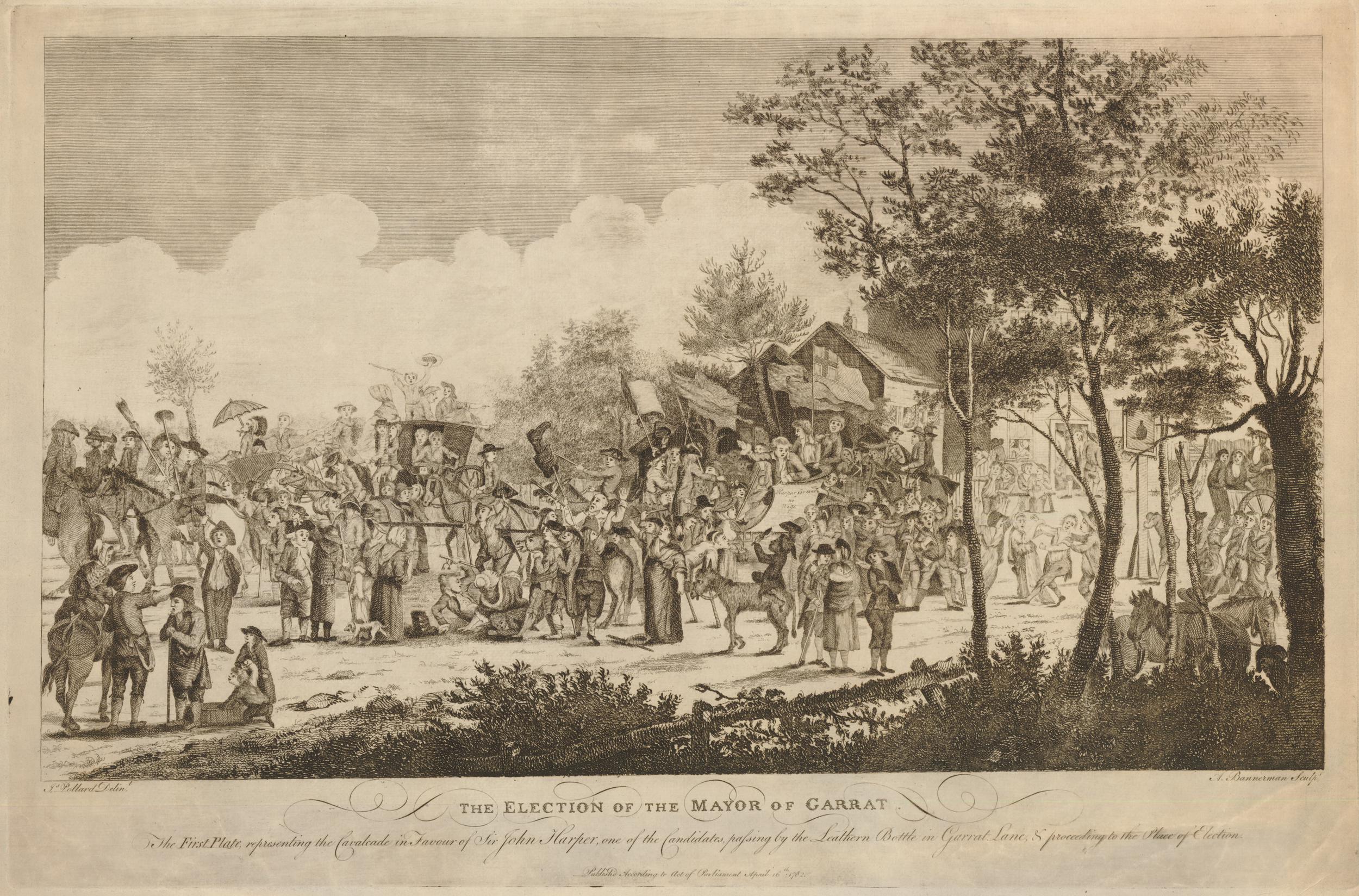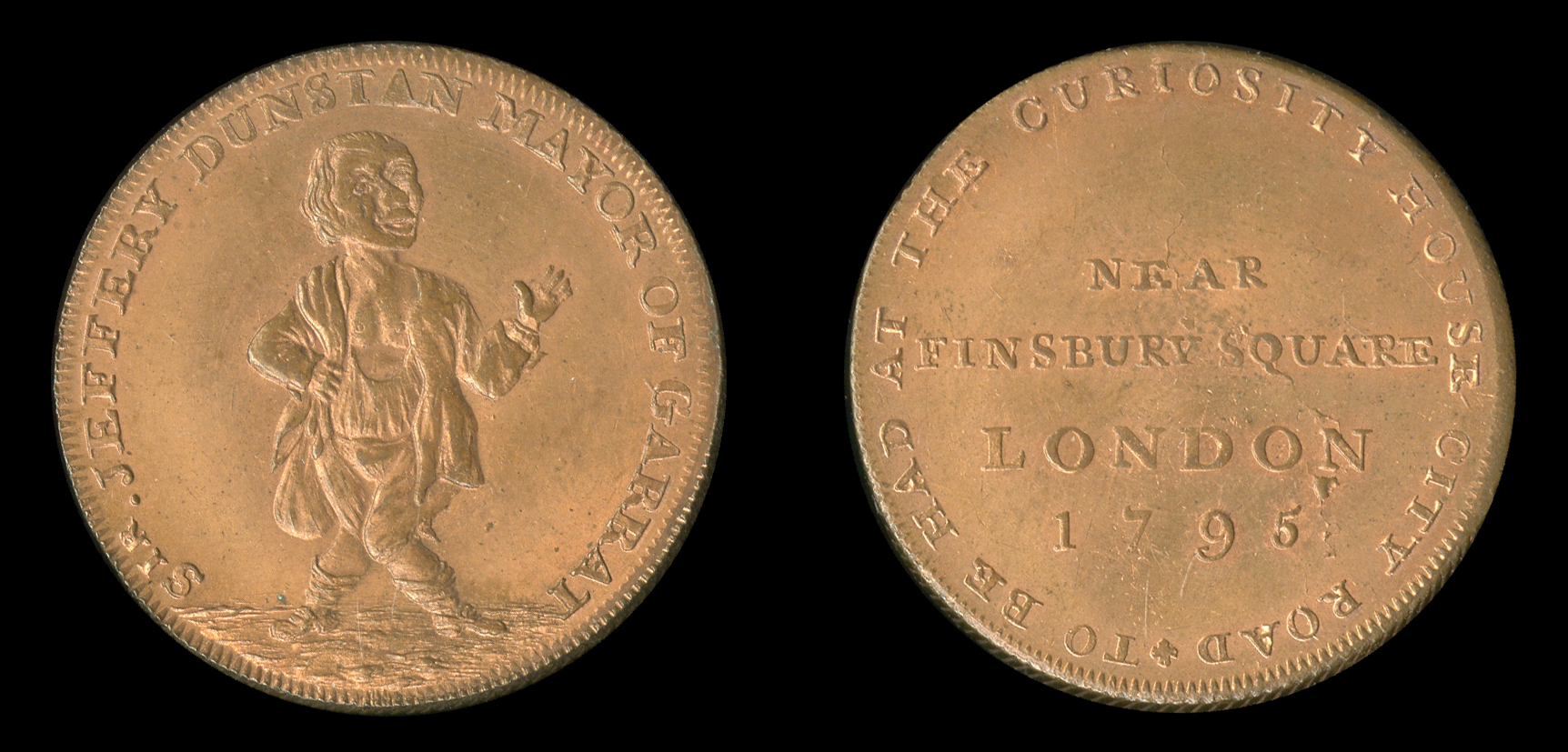One of the most curious and ludic phenomena of 18th-century popular politics
[5-minute read]
June 1768. Fifes, French horns, drums, and marrow bones can be heard in the streets of Wandsworth, now in south-west London but then still largely rural. A crowd has gathered, lining the high street in the tiny village of Garratt. Men and women wear the blue and orange cockades of General Wade, and sport the blue and white ribbons of Sir John Harper. A procession of chimney sweeps and children lead the way before the candidates make their way to the hustings. A drunken drawl breaks out in the crowd. However, this isn’t the scene of an ordinary election. This is a mock election.[1]
In the eighteenth century, parliamentary and municipal elections spurred the parallel culture of mock or burlesque elections. These events were usually held to coincide with parliamentary elections, despite electing a ‘mock mayor’. Drawing from the established proceedings of parliamentary elections, mock elections brought local communities together around speeches on the hustings, the printing and distribution of broadsides, processions, music, dancing, and drinking as depicted in a 1782 print (Figure 1). The mock mayor’s role was honorary, without any real political power. However, he did in some senses represent the interests of non-voters, street sellers and tradespeople of the lower social strata, interjecting their voice into political discourse.

The most famous mock election was the Garratt election, which was held in the village of Garratt near Wandsworth, Surrey following parliamentary elections. It is not known when the tradition of the mock election in Garratt started, but a letter from 1754 indicated that sixty to seventy years prior, a group of watermen went to the Leather Bottle public house and came up with the idea. It was a tradition that lasted until at least 1806, with a failed revival attempt in 1826. The actual elections for the county of Surrey took place in Guildford, over twenty-five miles away from Garratt. The nearest borough constituency was Southwark, some seven miles to the north-east. Garratt elections were held approximately a month after the official parliamentary elections, regardless of whether the election was contested or not. In 1796 for instance, Southwark’s election took place on 28 May; Surrey’s county election took place three days later on 1 June; and the Garratt election followed on 21 June, providing both geographic and temporal distance between the real and mock proceedings.[2]
Made famous by Samuel Foote’s 1763 farce The Mayor of Garret, the Garratt elections were the most elaborate by far. The ‘mock mayors’ became pseudo-celebrities, with broadsides printed to support their campaigns, as well as caricatures to lampoon them. Token halfpennies were even coined with their image (Figure 2). Foote’s play satirised the mock proceedings, poking fun at the tradespeople aping the modes of polite society. It was performed a total of 252 times between 1763 and 1796.[3] The right to vote in the Garratt election was not based on property ownership, but proverbially, on ‘having enjoyed a woman in the open air within that district’.[4] The candidates came from the ranks of street sellers and tradesmen (the grimier the better) who adopted titles and ridiculous names. In 1781, the candidates included: ‘Lord Viscount Swallowtail’ (a basket maker), ‘Sir John Harper’ (a breeches maker and inkle weaver), ‘Sir William Blaize’ (a blacksmith), ‘Sir Christopher Dashwood’ (a waterman), and ‘Sir Jeffrey Dunstan’ (a second-hand wig seller, pictured in Figure 2).[5] Parodying court dress, ‘Sir John Harper’, the triumphant candidate, was dressed in ‘a Pale Pink Suit of Silk Clothes, with Pea-green Cuffs, richly embroidered with Silver, and wore the Ensigns of the Garter’ as he processed down the streets of Southwark and Wandsworth in a phaeton carriage with six horses, quite the elaborate display for a breeches maker.[6] While these descriptions sound exaggerated, and could be deliberate and well-understood hyperbole, the financial burden for the extravagant clothing and farcical scenery was not felt by the candidates themselves. The festivities were reportedly funded by local brewers who were sure to make a profit by serving copious quantities of beer and ale, although according to another source in 1768, campaign costs were defrayed by a subscription of the people of Wandsworth.[7]

A few of the speeches and broadsides from the Garratt elections have been preserved. William Hone’s Every-Day Book, Or: Everlasting Calendar of Popular Amusements from 1827 published one of Jeffrey Dunstan’s speeches from 1785. Dunstan’s ‘campaign promises’ included abolishing the use of money to prevent bribery and corruption, ‘which all the big wigs of Westminster cannot prevent’, supporting ‘Sugar Plumb Billy’ (William Pitt the Younger) to pay off the national debt, unmarrying men and women, eliminating taxes, and discovering the secret of Freemasonry.[8] Presented in a joking style, this ‘manifesto’ blended farcical ideas with serious concerns about debt, taxation, and corruption. Despite the raucous atmosphere of burlesque elections, these were events which brought together local communities, celebrating and including men and women from the lowest social strata who were typically excluded from more elevated election festivities such as dinners and balls.
While the Garrett ceremony mocked official political systems, it also engaged with them, provided local residents opportunities to contribute to critique electoral processes and debates. The ceremony (and reporting) parodied but also imitated speeches made on the hustings and promises made by candidates, in some sense opening up political discourse to the whole community. The mock election blended ‘high’ and ‘low’ cultures, setting the two in direct contrast to poke fun at the serious responsibility of voters and voting. However, the procedure of the mock elections highlights the intrinsic familiarity and understanding of the processes, people, and rhetoric of parliamentary elections possessed by non-voters. The men, women, and children attending the mock proceedings would not have been able to effectively satirize the parliamentary elections if they did not understand it.
Mock elections also took place around England, particularly in Cornwall, Devon, Staffordshire, Northumberland, Surrey, and Middlesex. In July 1827, a mock election was even held by inmates of the King’s Bench Prison in Southwark. It was taken very seriously by all involved, with speeches, publications and actual polling. It ended with the warders calling in a squad of soldiers with fixed bayonets to break up a riot. Benjamin Haydon, then imprisoned there for debt, produced two largescale paintings of these events, one of which was sold to George IV for 500 guineas
During the 1796 general election, which ran from 25 May to 29 June, a ‘caricature’ election and procession of the ‘Mock Lord-Mayor for Knightsbridge’ (in the borough of Westminster) took place in Brompton, Middlesex on 20 June. The procession celebrated the lower orders of society, as the mock mayor’s cart was drawn by chimney sweeps and accompanied by ‘liberty boys, waving four dirty pocket-handkerchiefs’.[9] The presence of chimney sweeps highlights the involvement of children in parliamentary elections, though elsewhere this role was typically filled by women and girls dressed in virginal white.[10] The contrast between the young girls dressed in white and the grubby chimney sweeps with dirty handkerchiefs emphasized the world turned upside-down element of the mock election. The Hampshire Chronicle recounted:
The Lord Mayor elect made a speech aptly enough, remarking on the duties of the important office he was entering upon, and assuring the multitude that, although his august Brother eastward-ho [London Mayor William Curtis] had raised the bread, it should be his first care to bring it down again. He then harangued, in mock parliamentary language, on the honourable freedom of election. Six dung-carts and four wheel-barrows were filled by the electors, whom his lordship complimented on the independent spirit by which they had chosen him…[11]
Although mock electoral promises had no weight behind them, the mock mayor’s ‘first care’ to bring down the price of wheat and shortage of bread genuinely appealed to the concerns of those deemed to be at the bottom of society — chimney sweeps, watermen, blacksmiths and all. In the 1790s, the average price of wheat had soared due to the war with Revolutionary France. The cost of living made life harder for those across the spectrum, but particularly for the most vulnerable in society. A Winchester bushel of wheat cost approximately 5s. 10d. in January 1793, but peaked at over 12s. 6d. in March 1796, three months before the general election.[12] The mock mayor critiqued those in elected office who regulated the price of bread and wheat, using his position in the proceedings to voice the genuine concerns of fellow tradesmen.
While some areas of England still have vestiges of mock elections with mock mayors (ie. the Mayor of the Quay in Penzance and the Mayor of Ock Street in Abingdon-on-Thames), their political potency has dwindled. However, it is still possible to visit the site of the Garratt elections. Getting off the train at Earlsfield station, Garratt Lane is much quieter, lined with houses, fish and chip takeaways, a post office, and barbers shops. The hubbub of the festivities of past centuries have faded away. However, if you walk down Garratt Lane far enough, you can still visit the Leather Bottle for a pint.
[1] A Description of the Mock Election at Garrat (London, 1768).
[2] Hampshire Chronicle (25 June 1796), p.3 col. d.
[3] ‘Data Associations: The Mayor of Garratt’, The London Stage (2022) <https://www.eighteenthcenturydrama.amdigital.co.uk/LondonStage/CoOccurrence#wp> [accessed 16 November].
[4] Francis Grose, A Classical Dictionary of the Vulgar Tongue (London, 1785), 70.
[5] Oxford Journal (28 July 1781), p.2 col. b.
[6] Oxford Journal (28 July 1781), p.2 col. b.
[7] John Brewer, ‘Theater and Counter-Theater in Georgian Politics: the Mock Elections at Garrat’, Radical History Review, 22 (1979): p.10; A Description of the Mock Election at Garrat, 2.
[8] Hone, 831.
[9] Hampshire Chronicle (25 June 1796), p.3 col. d.
[10] Katrina Navickas, ‘“That sash will hang you”: Political Clothing and Adornment in England, 1780-1840’, Journal of British Studies,49/3 (2010): 556.
[11] Hampshire Chronicle (25 June 1796), p.3 col. d.
[12] Walter Stern, ‘The Bread Crisis in Britain, 1795-5’, Economica, 31/122 (1964): 169.


